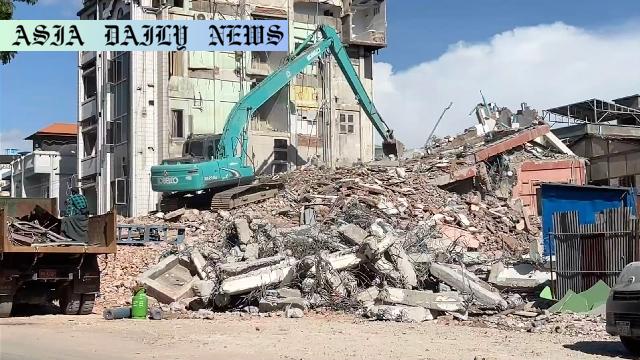Myanmar earthquake highlights a neglected crisis as thousands still suffer three months after the devastating 7.7 quake.

The Myanmar Earthquake: An Unfolding Humanitarian Crisis
On March 28, 2023, Myanmar was struck by a devastating 7.7 magnitude earthquake that wrought havoc in central regions, leaving behind a trail of destruction that the country is still struggling to recover from three months later. The scale of the tragedy was enormous, with over 3,700 people losing their lives while thousands more sustained injuries. Entire communities have been uprooted, forcing many to live in tents and other makeshift shelters as they face an uncertain future.
The earthquake inflicted significant damage on Myanmar’s infrastructure, particularly in Mandalay, the country’s second-largest city. With homes flattened and critical structures in ruin, progress in rebuilding has been slow and arduous. Residents and local authorities have been battling against scarcity of resources, insufficient international aid, and a complete disruption of normal life and business. Many residents, such as a 35-year-old woman who still resides in a tent with her family, express hopes of rebuilding, yet financial obstacles remain insurmountable for most. This lack of resources is compounded by the broader economic impact, as businesses struggle to resume operations, and unemployment soars.
A Plea for Continued International Support
Despite the overwhelming needs, global interest and support for Myanmar’s earthquake recovery efforts seem to be dwindling, according to Titon Mitra, the United Nations Development Programme (UNDP) Chief in Myanmar. Highlighting this issue, Mitra stated that Myanmar’s plight is not merely a “forgotten crisis,” but a “neglected crisis.” This distinction is significant, as it reflects the ongoing nature of the humanitarian needs and the lack of substantial international engagement. Immediate actions, such as sustained donations, grants, and development aid, are critical to ensuring Myanmar can get back on its feet.
Small businesses, in particular, are hit hard. A 53-year-old sewing factory owner, still reeling from the disaster, finds himself unable to continue operations without funding. His plight underscores the ripple effect the earthquake has had on local economies, with thousands unable to contribute to livelihoods and productivity. Moreover, these financial setbacks widen existing gaps in economic stability and deepen the overall humanitarian crisis.
Addressing the Human and Economic Toll of the Earthquake
The challenges presented by the Myanmar earthquake extend far beyond the immediate loss of lives and property. The humanitarian crisis has exposed systemic weaknesses in disaster preparedness and recovery in the region. Restoration of essential services—such as water, electricity, and communication—is far from complete, leaving many residents stranded in precarious conditions. Temporary shelters lack essential resources, with women and children being disproportionately impacted by the lack of security and health services in camps. The emotional and psychological toll remains stark as survivors grapple with grief and trauma unleashed by the disaster.
Rebuilding Myanmar will require a comprehensive response from both national and international stakeholders. Strengthened partnerships and multi-tiered recovery plans that address both short-term needs, such as temporary housing, and long-term goals, such as rebuilding infrastructure and restoring the economy, are crucial. Aid agencies must coordinate efforts to prevent Myanmar’s crisis from slipping out of global focus, especially given the risk of recurring natural disasters in the region.
Commentary
The Dangers of Waning Global Awareness
It is disheartening to note that, three months after a devastating 7.7 magnitude earthquake, Myanmar faces a dire lack of global attention to its ongoing crisis. The slowing pace of international aid reflects a pattern often seen in global disasters—the world rallies in the immediate aftermath, but support dwindles just as the long recovery process begins. This is an issue that must be urgently addressed if Myanmar is to have any hope of rebuilding effectively.
Highlighting the Human Cost
The survivors in Myanmar are enduring unimaginable challenges. Living in tents and temporary shelters, families are battling harsh weather, insufficient resources, and the psychological strain of losing their homes and loved ones. Their harrowing stories, such as a mother struggling to rebuild her family’s life amidst financial challenges, highlight the dire state of those most affected. These individuals can rebuild, but only if global support provides the proper framework to enable their efforts. Financial constraints must be tackled with robust aid programs.
A Call to Action
Titon Mitra’s concern about Myanmar becoming a “neglected crisis” is valid and should serve as a wake-up call for the international community. Governments, non-governmental organizations, and philanthropic bodies must band together to prioritize this crisis. Targeted donations, rapid implementation of reconstruction projects, and consistent advocacy for Myanmar’s plight are essential to restore dignity and security to the affected people.
Myanmar’s earthquake is a sobering reminder of both the resilience of humanity and the need for sustained, united efforts in the face of adversity. If we allow interest to wane further, we risk abandoning thousands of people who still desperately need our help.


